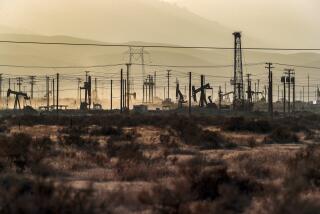Cutting Edge: Santa Monica firm says it has found a way to salt away electricity, literally
- Share via
In the energy world, the ability to store electricity at an affordable price is the treasure sought by utility engineers and financial wizards.
SolarReserve believes it has found a solution.
The Santa Monica company recently completed what it touts as a first-of-its-kind solar power plant that stores electricity using salt. The facility, in Nevada between Reno and Las Vegas, is 20 times larger than a SolarCity-Tesla solar and storage operation in Hawaii, which incorporates batteries.
SIGN UP for the free California Inc. business newsletter >>
Called Crescent Dunes, the SolarReserve power plant is a 110-megawatt facility with 10 hours of energy storage. That translates into 1,100 megawatt hours of storage, enough to power 75,000 homes. In other words, the facility can run for an additional 10 hours at the full 110 megawatt output just from the stored energy, with zero sunshine.
Crescent Dunes manages this by using rings of billboard-size mirrors to reflect the sun onto a tower filled with salt. The molten salt boils water, producing steam that powers electricity-generating turbines.
With California’s requirement that 50% of the state’s electricity generation come from renewable sources such as solar and wind power by 2030, storage facilities such as Crescent Dunes have great potential.
“So far, in the industry that’s the state of the art, molten salt storage,” said Yogi Goswami, a professor at the University of South Florida and an expert on solar power.
Goswami, who has experimented with salt storage at the Tampa university, said SolarReserve is demonstrating the commercial potential of the technology. But such energy storage has drawbacks, he said, including the corrosive nature of salt and the high cost.
SolarReserve has gotten around the corrosion problem by encapsulating the salt in ceramic balls.
------------
FOR THE RECORD
March 21, 11:25 a.m.: An article in the March 20 Business section about a solar power plant that stores electricity using molten salt stated that the SolarReserve facility uses ceramic balls to encapsulate the salt as a way to avoid corrosion. The facility doesn’t use such a method. University of South Florida professor Yogi Goswami has used that technique in his work on energy storage.
------------
As for the cost: The price tag for Crescent Dunes was $1 billion, or about 13.5 cents a kilowatt hour, roughly twice as much as the lowest-priced natural gas facility, which can run at about 7 cents to 9 cents a kilowatt hour.
Because SolarReserve custom-designed the Crescent Dunes facility, the company said it was a bit pricier than it expects future units to cost. The company expects future plants to be more competitive with natural gas facilities less than 10 cents a kilowatt hour.
Past tower technologies such as ESolar’s Sierra SunTower, a small pilot project that began producing electricity in 2009 in Lancaster, used solar thermal technology that proved costly to operate. Solar thermal technology uses panels to heat liquids. The liquids flow through pipes to boil water and generate steam that powers turbines.
Because of the cost of solar thermal, ESolar and other firms began pursuing molten salt storage as a cheaper alternative.
For now, the biggest advantage of a facility such as Crescent Dunes, the company said, is that it doesn’t require natural gas or other fossil fuels, yet it can run round-the-clock. SolarReserve said the utility that buys the electricity produced at the facility wants it for only about 16 hours a day.
In the downtime, the salt never becomes a solid. The temperature never falls below 500 degrees and reaches 1,050 degrees when heated — three times the temperature used to bake a cake.
U.S. Sen. Harry Reid (D-Nev.), said in a statement that Crescent Dunes shows “what is possible when the public and private sectors come together to build the next generation of clean energy technology.”
Kevin Smith, chief executive and co-founder of SolarReserve, said that if California and the rest of the nation are to meet clean energy goals, power storage or more fossil fuel plants will be needed to provide support for when the wind isn’t blowing or the sun isn’t shining.
“The way California is going to solve that is either with plants like ours or conventional natural gas,” Smith said. “We’re a few years away before the U.S. starts taking storage more seriously. Right now the U.S. market isn’t demanding as much storage as some of the international markets.”
SolarReserve has been working to build solar storage facilities across the globe, including one of the largest such operations in northern Chile’s Atacama Desert. SolarReserve also has operations in China, South Africa and Dubai.
In Nevada, SolarReserve’s Crescent Dunes supplies electricity to NV Energy. Company spokeswoman Faye Andersen acknowledged that the facility provides power to NV Energy but declined to comment further about the operation.
Although California is by far the nation’s leader in generation of solar power, the state has not capitalized on storage technologies.
Southern California Edison operates one of the largest storage units at its Tehachapi facility, which uses lithium-ion batteries to store wind power.
David Song, an Edison spokesman, said the Tehachapi storage facility operates at 32 megawatt hours, or about 3% of SolarReserve’s Crescent Dunes plant. Song declined to speculate about the viability of a facility such as Crescent Dunes within the Rosemead utility’s operation.
Smith co-founded SolarReserve in 2008 and now has seven international offices that operate in 20 countries and 114 employees.
Smith said he believes his company’s technology will increasingly capture California’s attention as it spreads across the globe, even though the state’s utilities haven’t wanted to tap the new operation just yet.
“Right now they’re not focusing on implementing these storage solutions,” Smith said.
“But it will come. It has to by definition.”
Twitter: @ivanlpenn
ALSO
Hulk Hogan verdict raises crucial privacy issues in the digital age
Lucy Jones is leaving her job - to shake up more than just earthquakes
Lopez: Trump circus rolls into Phoenix in a taste of what’s in store for California







